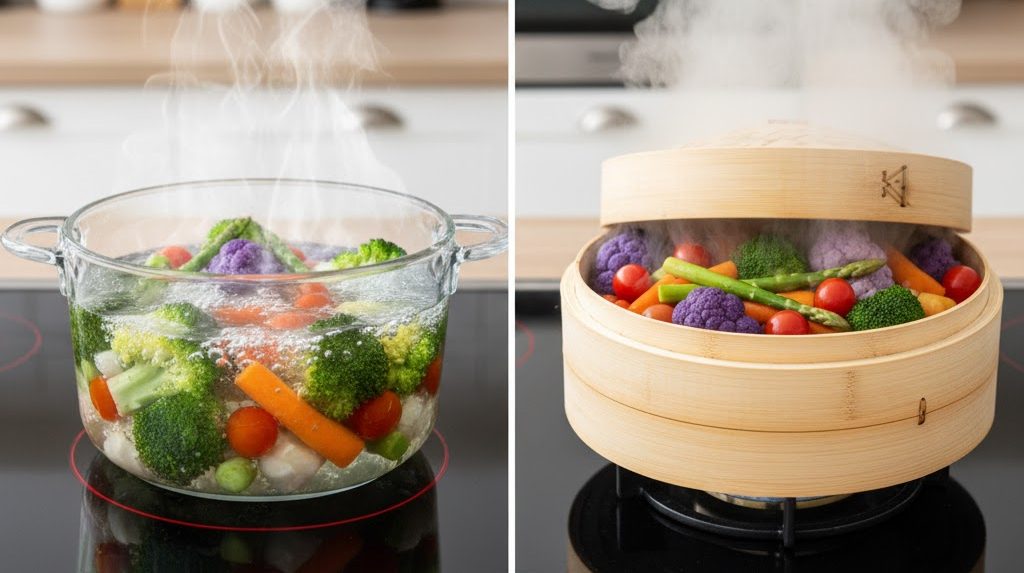Cooking vegetables may seem simple, a pot of boiling water or a steaming basket over it ,yet the choice between steaming and boiling can dramatically change how your vegetables taste, look, and nourish your body. Both are classic, oil-free methods for healthy cooking, but the way heat meets your food makes all the difference.
Steaming: Gentle, Bright, and Nutrient-Packed
Steaming uses the vapour from simmering water to cook vegetables without immersing them. This gentle technique allows veggies to retain most of their water-soluble vitamins, such as Vitamin C and B-complex, which often get washed away during boiling. The result? Crisp-tender vegetables that keep their vibrant colours, fresh aroma, and natural sweetness intact.

Because the vegetables never touch the water, they hold onto more of their antioxidants and phytonutrients. Studies published in the Journal of Agricultural and Food Chemistry show that steaming preserves higher levels of beta-carotene, flavonoids, and Vitamin C compared to boiling. Even though some vitamin loss occurs, it’s far less, around 10-15% versus over 50% in boiling.
Pro tip: Add a dash of herbs, lemon juice, or a few drops of olive oil after steaming to elevate flavour without compromising nutrition.
Boiling: Comforting, Convenient, and Still Useful
Boiling remains a go-to for many because it’s quick and effortless, just drop your vegetables into a pot of hot water and wait a few minutes. It’s ideal for starchy vegetables such as potatoes, sweet potatoes, corn, and beetroot, which develop a soft, creamy texture that steaming can’t quite replicate.

However, boiling has a nutritional downside. When vegetables are submerged, many vitamins and minerals leach into the cooking water. Unless you use that water in soups, curries, or dals, those nutrients are lost. Overboiling can also dull colours and soften textures, leaving vegetables mushy and bland.
Pro tip: Salt the boiling water for better flavour, and never discard the leftover broth, it’s packed with nutrients that can enrich other dishes.
The Key Differences
Aspect |
Steaming |
Boiling |
How it cooks |
Vapour cooks food above water |
Vegetables fully submerged |
Nutrient retention |
High |
Lower |
Texture |
Firm and crisp |
Soft, sometimes mushy |
Flavour |
Fresh and natural |
Milder, diluted |
Best for |
Greens, broccoli, beans, carrots |
Potatoes, beetroot, corn |
In short, boiling offers comfort and speed, while steaming delivers care and nutritional precision.
Nutrition Matters Most
If your goal is to keep your plate vibrant and nutrient-rich, steaming is the clear winner. Research consistently shows that steaming helps preserve antioxidants, vitamins, and the plant compounds responsible for protecting the body from chronic diseases. It also keeps vegetables lighter on the palate and easier to digest.
Ayurveda has long praised steaming as a sattvic method, one that maintains the food’s prana (life energy). According to Dr. Ritika Samaddar, Regional Head of Dietetics at Max Healthcare, “Steaming is among the healthiest cooking methods. It preserves vitamins and minerals without oil, making it ideal for people managing weight, diabetes, or heart conditions.”
Common Mistakes to Avoid
When steaming
-
Don’t oversteam, vegetables should be tender-crisp.
-
Avoid crowding the basket to let steam circulate freely.
-
Cut vegetables evenly for uniform cooking.
-
Season lightly, steamed food can be subtle.
When boiling
-
Don’t overcook; 3–6 minutes is enough for most veggies.
-
Always start with boiling water, not cold.
-
Reuse the cooking water whenever possible.
-
Blanch greens briefly, then plunge into cold water to keep their colour bright.


